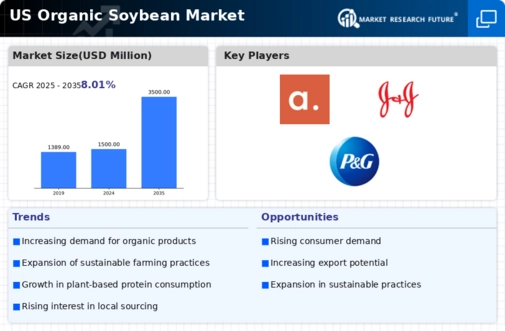Sustainability Initiatives
Sustainability initiatives are becoming increasingly relevant in the organic soybean market. As environmental concerns grow, consumers and producers alike are prioritizing sustainable agricultural practices. The organic soybean market is likely to see a boost as farmers adopt eco-friendly methods that align with consumer values. According to the USDA, organic farming practices can lead to improved soil health and biodiversity, which are essential for long-term agricultural sustainability. In 2025, the market for organic soybeans may expand as more consumers seek products that contribute to environmental conservation. This shift towards sustainability not only enhances the appeal of organic soybeans but also aligns with broader trends in the food industry, where sustainability is becoming a key purchasing criterion.
Growing Export Opportunities
The organic soybean market is likely to experience growth due to expanding export opportunities. As global demand for organic products increases, the US is well-positioned to become a leading exporter of organic soybeans. Countries in Europe and Asia are showing a rising interest in organic food, which could create lucrative markets for US producers. In 2025, the export value of organic soybeans may reach new heights, driven by favorable trade agreements and increasing international consumer awareness of organic products. The organic soybean market stands to gain from this trend, as producers capitalize on the growing appetite for organic soybeans in foreign markets, thereby enhancing their profitability and market reach.
Supportive Government Policies
Supportive government policies are playing a crucial role in shaping the organic soybean market. Initiatives aimed at promoting organic farming, such as subsidies and grants, are likely to encourage more farmers to transition to organic practices. The USDA has implemented various programs to support organic agriculture, which may lead to increased production of organic soybeans. In 2025, the organic soybean market could see a surge in growth as these policies foster a more favorable environment for organic farming. Additionally, government regulations that promote transparency and labeling in organic products may enhance consumer trust, further driving demand for organic soybeans. This supportive framework is essential for the long-term sustainability and expansion of the organic soybean market.
Health Consciousness Among Consumers
The increasing awareness of health and wellness among consumers appears to be a pivotal driver for the organic soybean market. As individuals become more informed about the benefits of organic products, the demand for organic soybeans is likely to rise. Studies indicate that organic soybeans are perceived as healthier alternatives due to their lack of synthetic pesticides and fertilizers. In 2025, the organic food market in the US is projected to reach approximately $70 billion, with organic soybeans playing a significant role in this growth. This trend suggests that consumers are willing to pay a premium for organic products, thereby enhancing the market's potential. The organic soybean market is thus positioned to benefit from this shift in consumer preferences, as health-conscious individuals increasingly seek out organic options in their diets.
Technological Advancements in Agriculture
Technological advancements in agriculture are poised to transform the organic soybean market. Innovations such as precision farming, biotechnology, and data analytics are enabling farmers to optimize yields while adhering to organic standards. These advancements may lead to increased efficiency and reduced costs, making organic soybean production more viable. The organic soybean market could benefit from these technologies, as they allow for better pest management and resource utilization. For instance, the adoption of drones and sensors in farming practices is expected to enhance crop monitoring and management. As these technologies become more accessible, the organic soybean market may experience growth driven by improved production methods and higher quality products.














Leave a Comment